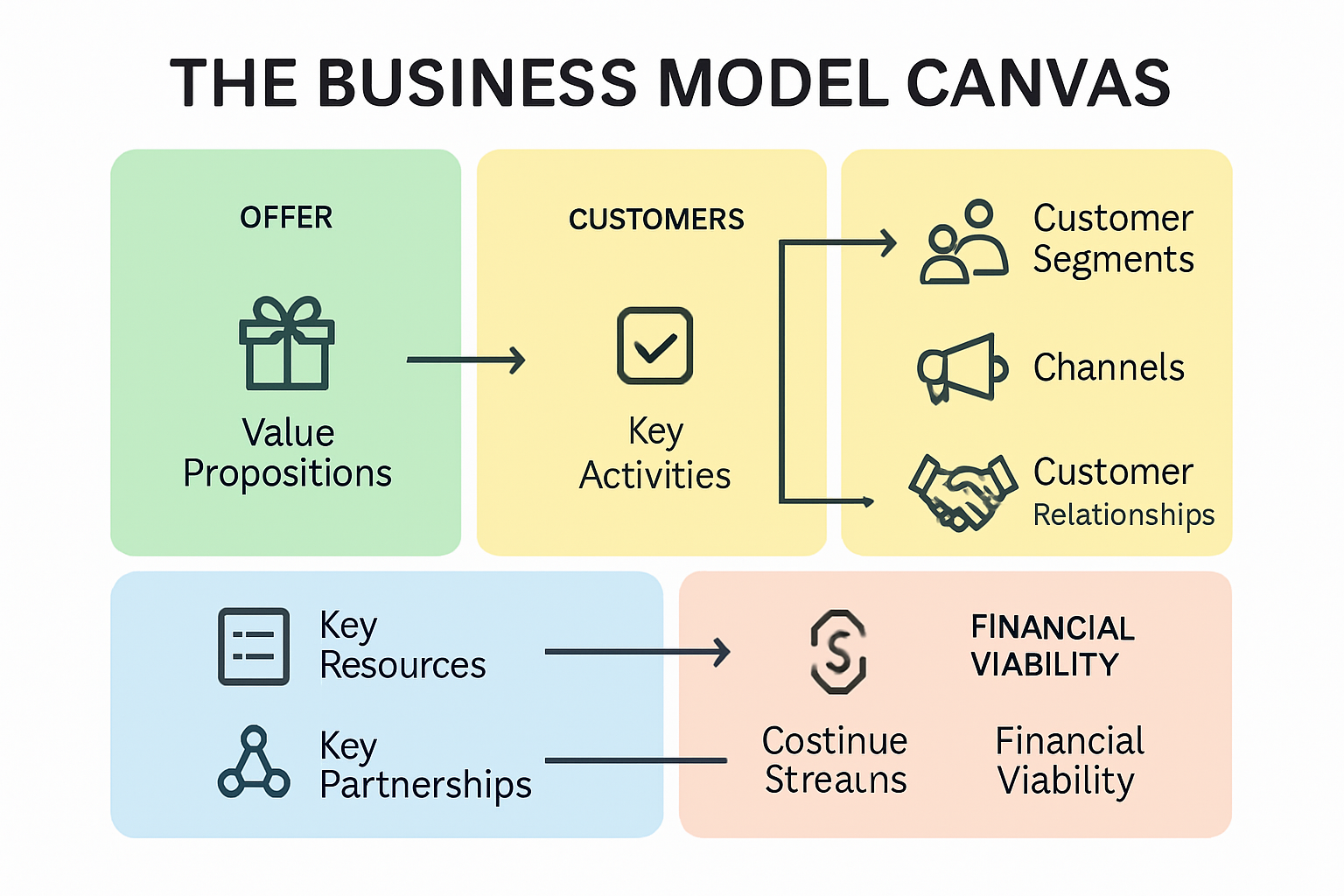
Business Canvas Model 2025: Simple Guide for New Entrepreneurs
The Business Canvas Model is everywhere these days and entrepreneurs are calling it their shortcut to turning ideas into real businesses. Most people think planning a startup has to mean pages of financials and dense reports. Not even close. With nine simple building blocks that fit on a single page, this visual tool is helping founders move from overwhelmed to organized in record time. Here is why new founders are ditching the old playbook for something smarter.
Table of Contents
- What Is The Business Canvas Model?
- The Nine Essential Building Blocks
- Why Entrepreneurs Love The Business Canvas Model
- Nine Key Building Blocks Explained
- Customer-Centric Components
- Operational And Strategic Building Blocks
- Financial Foundation
- How To Easily Fill Out Your Canvas
- Start With Customer Understanding
- Map Your Internal Capabilities
- Financial Modeling And Validation
- Real-World Tips For First-Time Founders
- Embrace Iterative Development
- Strategic Problem Solving
- Financial And Operational Pragmatism
Quick Summary
What Is the Business Canvas Model?
The Business Canvas Model represents a strategic planning tool that transforms complex business strategies into a clear, visual framework. Unlike traditional business plans buried in dense text and financial projections, this model provides entrepreneurs with a streamlined approach to understanding and communicating their business concept.
The Nine Essential Building Blocks
According to OpenStax’s Entrepreneurship textbook, the Business Model Canvas consists of nine interconnected components that collectively describe how a business creates, delivers, and captures value. These nine blocks are not isolated elements but an integrated system that reveals the underlying logic of how a company operates.
The nine essential building blocks include:
- Customer Segments: Who are your target customers? Understanding their needs, behaviors, and preferences is crucial.
- Value Propositions: What unique solutions does your business offer? This block defines the products or services that solve customer problems.
- Channels: How will you reach and communicate with your customers?
- Customer Relationships: What type of relationship will you establish with each customer segment?
- Revenue Streams: How will your business generate income?
- Key Resources: What strategic assets are required to deliver your value proposition?
- Key Activities: What core actions must your business perform to succeed?
- Key Partnerships: Who are the external organizations critical to your business model?
- Cost Structure: What are the most significant expenses in your business operations?
To help you quickly scan and compare the focus of each Business Model Canvas building block, see the summary table below.
Why Entrepreneurs Love the Business Canvas Model
The U.S. Small Business Administration emphasizes that the Business Model Canvas allows entrepreneurs to understand how different components of their business interrelate. It provides a visual chart that makes complex business strategies more accessible and easier to modify. Unlike rigid traditional business plans, the canvas encourages flexibility and continuous iteration.
The model’s beauty lies in its simplicity. By presenting business strategy on a single page, entrepreneurs can quickly communicate their vision, identify potential gaps, and pivot when necessary. It transforms abstract business concepts into a tangible, actionable blueprint.
For new entrepreneurs feeling overwhelmed by complex business planning, our guide on turning startup ideas into reality offers additional insights into strategic planning and business model development. The Business Canvas Model isn’t just a tool it’s a compass that helps navigate the intricate landscape of entrepreneurship with clarity and purpose.
Nine Key Building Blocks Explained

Understanding the nine key building blocks of the Business Model Canvas transforms abstract business concepts into a concrete strategic roadmap. The Open University’s OpenLearn platform highlights that these components cover four critical business dimensions: offer, customers, infrastructure, and financial viability.
Customer-Centric Components
The first four building blocks center on understanding and serving your target market. According to SCORE’s business model guide, these components help entrepreneurs create a laser-focused approach to customer engagement:
- Customer Segments: Identify specific groups who will benefit most from your product or service. Not all customers are created equal. Some might be early adopters, while others represent long-term strategic relationships.
- Value Propositions: Define the unique solutions you offer. What problem do you solve? How are you different from competitors? This block is where innovation meets customer needs.
- Channels: Determine how you’ll reach and communicate with your target audience. Will you use digital marketing, direct sales, partnerships, or a combination of strategies?
- Customer Relationships: Outline the type of interaction you’ll maintain. Will you provide personal assistance, self-service options, or automated support?
Operational and Strategic Building Blocks
The next three blocks focus on the internal machinery that powers your business model. OpenStax’s organizational research emphasizes that these components reveal the core capabilities required to deliver your value proposition:
- Key Resources: Identify the critical assets needed to operate. These could be physical (equipment), intellectual (patents), human (skilled team), or financial resources.
- Key Activities: Outline the most important actions your business must perform. What core processes are essential to creating and delivering your value proposition?
- Key Partnerships: Recognize external relationships that enhance your business model. Who are the strategic allies that can help you optimize operations, reduce risks, or access new markets?
Financial Foundation
The final two building blocks complete the business model by addressing financial sustainability:
- Revenue Streams: Clarify how your business will generate income. Will you use subscription models, one-time sales, licensing, or multiple revenue channels?
- Cost Structure: Analyze your business expenses. Are your costs primarily fixed or variable? Understanding your cost drivers helps in maintaining financial health and planning strategic investments.
Below is a summary table categorizing all nine Business Model Canvas building blocks into their main business dimensions for easy reference.
These nine building blocks are not static elements but a dynamic system that entrepreneurs can continuously refine. Learn more about transforming startup ideas into actionable strategies and master the art of business model design. Remember, the Business Model Canvas is your strategic compass a tool that helps you navigate the complex terrain of entrepreneurship with clarity and purpose.
How to Easily Fill Out Your Canvas
Filling out a Business Model Canvas requires strategic thinking and systematic approach. The University of Missouri Libraries recommends a methodical process that transforms complex business ideas into a clear, actionable strategy.
Alternatively, you can watch this video tutorial from experts on how to do it:
Start with Customer Understanding
Begin by focusing on the right side of the canvas customer-facing components. Entrepreneurs often make the mistake of starting with their product instead of understanding their customers deeply. University of East London’s guide suggests answering critical questions for each customer-related block:
- Customer Segments: List specific groups. Ask yourself who truly needs your solution. Be precise about demographics, behaviors, and pain points.
- Value Propositions: Identify unique problems you solve. What makes your solution different? Write down specific benefits that address customer needs.
- Channels: Determine communication and delivery methods. Consider digital platforms, physical locations, and partnership networks.
- Customer Relationships: Define interaction strategies. Will you offer personal support, automated services, or community engagement?
Map Your Internal Capabilities
After understanding customer dynamics, shift focus to your internal operational capabilities. According to OpenStax’s Entrepreneurship textbook, this involves deep introspection about your business’s core strengths:
- Key Resources: List essential assets. These could include technology, intellectual property, team expertise, or financial capital.
- Key Activities: Outline core processes that deliver your value proposition. What must you excel at to make your business model work?
- Key Partnerships: Identify strategic relationships. Which external organizations can help you optimize operations or extend your reach?
Financial Modeling and Validation
Complete your canvas by addressing financial sustainability. This final step transforms your conceptual model into a viable business strategy:
- Revenue Streams: Specify income sources. How will customers pay? Consider subscription models, one-time purchases, or multiple revenue channels.
- Cost Structure: Analyze expense categories. Distinguish between fixed and variable costs. Understand your financial requirements for sustainable operations.
Remember that the Business Model Canvas is a living document. Explore our guide on turning startup ideas into actionable strategies to refine your approach. Start with rough drafts, discuss with mentors, and be prepared to iterate. The goal is not perfection but continuous improvement and strategic clarity.
Pro tip: Use sticky notes when initially filling out your canvas. This allows easy movement and reconfiguration as your understanding evolves. Flexibility is key in business model design.
Real-World Tips for First-Time Founders
Navigating the entrepreneurial landscape requires more than just a brilliant idea. The International Institute for Management Development emphasizes that successful entrepreneurs transform their Business Model Canvas from a theoretical blueprint into a practical roadmap for success.
Embrace Iterative Development
The Lean Startup methodology introduces a critical approach for first-time founders. According to lean startup principles, your first version doesn’t need to be perfect. Focus on creating a minimum viable product (MVP) that allows you to gather real-world customer feedback quickly:
- Validate Assumptions: Test your core business hypotheses through small, measurable experiments.
- Collect Feedback: Engage directly with potential customers to understand their genuine needs.
- Pivot or Persevere: Be prepared to modify your business model based on actual market response.
- Rapid Iteration: Treat your Business Model Canvas as a living document that evolves with your understanding.
Strategic Problem Solving
The Lean Model Canvas recommends a problem-first approach. Most first-time founders make the mistake of falling in love with their solution before truly understanding the problem:
- Deep Problem Analysis: Spend significant time understanding customer pain points.
- Solution Validation: Ensure your proposed solution genuinely addresses a significant market need.
- Market Research: Use qualitative and quantitative methods to verify your assumptions.
- Customer Interviews: Engage potential users to gain deeper insights into their challenges.
Financial and Operational Pragmatism

Successful entrepreneurship requires a balanced approach to resources and growth. Explore our comprehensive guide on startup growth strategies to understand how to manage your business effectively:
- Lean Resource Management: Minimize unnecessary expenses and focus on critical investments.
- Flexible Funding: Consider multiple funding sources beyond traditional venture capital.
- Network Building: Create strategic partnerships that can provide support and resources.
- Continuous Learning: Treat every challenge as an opportunity to improve your business model.
Remember, the Business Model Canvas is more than a document it’s a strategic thinking tool. Learn more about common challenges founders face and develop the resilience needed to transform your entrepreneurial vision into reality. The most successful founders are those who remain adaptable, curious, and committed to solving real-world problems.
Pro tip: Don’t work in isolation. Join entrepreneur networks, seek mentorship, and continuously challenge your assumptions. Your business model will thank you for the diverse perspectives and insights.
Frequently Asked Questions
What is the Business Canvas Model?
The Business Canvas Model is a strategic planning tool that provides a visual framework to help entrepreneurs outline their business strategies on a single page. It consists of nine essential building blocks that describe how a business creates, delivers, and captures value.
What are the nine building blocks of the Business Canvas Model?
The nine building blocks include Customer Segments, Value Propositions, Channels, Customer Relationships, Revenue Streams, Key Resources, Key Activities, Key Partnerships, and Cost Structure. Each block addresses a critical component of the business strategy.
How can I effectively fill out my Business Model Canvas?
Start by understanding your customers and their needs. Then, map your internal capabilities focusing on resources, activities, and partnerships. Finally, address financial aspects like revenue streams and cost structure. Remember to treat the canvas as a living document, iterating based on feedback and new insights.
Why do new entrepreneurs prefer the Business Canvas Model over traditional business plans?
Entrepreneurs prefer the Business Canvas Model because it simplifies complex strategies into a clear, visual format, making it easier to communicate and modify. Unlike traditional plans, it encourages flexibility and continuous iteration, helping founders adapt their business models as they gather real-world feedback.
Turn Your One-Page Business Model Into Real Action With siift
Feeling overwhelmed or stuck after filling out your Business Canvas? Many new founders find that translating clear visual plans into actual results is harder than expected. Issues like uncertainty over priorities, lack of unbiased feedback, and fear of missing important steps often turn early momentum into hesitation. This guide explained how powerful it can be to use nine simple building blocks, but making them work for your real business takes ongoing support and direction.
siift is built for founders exactly at this crossroad. Our intuitive AI platform gives you step-by-step guidance, helps you set actionable milestones, and provides personalized feedback on your canvas and strategy. Need extra clarity before launching? Ready to put theory into practice and minimize risk from the start? Visit siift to see how you can turn your Business Canvas into a living business plan. Signing up is free and you can get started today. Start building your action plan now and move your business idea forward with confidence.
Recommended
- blog | siift | Business Plan Essentials 2025: A Beginner’s Guide for New Founders
- blog | siift | How to Find Business Ideas in 2025: Proven Steps for Students and New Grads
- blog | siift | Top Reasons Businesses Fail in 2025: A Guide for New Founders
- blog | siift | Creative Thinking Exercises for Future Entrepreneurs 2025
- Mobile App Development Process for Businesses in 2025
- A/B Testing for Small Businesses: Boost Results in 2025

see where you stand





.svg)
.svg.png)



.svg)

